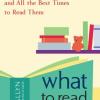 |
What to Read When: The Books and Stories to Read with Your Child – and All the Best Times to Read Them
By Pam Allyn ’84
Reviewed by Phoebe Yeh ’84
You are trying to find a book for your 7-year-old. His teacher says he has to read something besides a Magic Tree House book. You are at a bookstore, frantically surveying the dizzying array of choices—face-out, spine out, piles on tables, displays on end caps. It is sensory overload. How do you begin to make an informed selection? Is it okay to choose a picture book even though he’s reading chapter books? He loves the Magic Tree House books so much that he reads the same ones over and over again. Is that okay? Isn’t he supposed to be reading up? Is there such a thing as choosing the wrong book? Will you diminish his interest if you make a wrong choice? And what’s this about still reading aloud to a child who’s already reading by himself? For those in search of a pragmatic guide to choosing and reading children’s books aloud, spend some time perusing What to Read When: The Books and Stories to Read with Your Child – and All the Best Times to Read Them, by Pam Allyn, longtime educator; founder and executive director of LitLife; founder of Books for Boys, a literacy organization for young people in foster care; founder of LitWorld, a global literacy organization for educators; and parent. But first and foremost, devoted reading enthusiast.
What to Read is not the only guide in the marketplace. But it offers a uniquely personal perspective on the infinite tangible and intangible pleasures of reading and sharing children’s books with others. As the author recounts a cherished childhood memory of hearing her mother read Blueberries for Sal, perhaps it will spark your own memories of reading and rereading The Little Engine That Could or Where the Wild Things Are.
But maybe reading aloud isn’t second nature to you. The author offers practical tips to the tried and untried caregiver. It’s not just about reading the story. There are ways to enhance the experience, to engage the reader, to create dialogue between caregiver and child. It’s more than just reading a story together. Allyn’s advice is concrete and reassuring. But even a seasoned reader can benefit from the reminders of the simple yet long-lasting pleasures derived from reading to and reading alongside your children. And not just books, mind you. It could be a newspaper article, the comics, a magazine piece, an obituary.
The book is comprised of sections that are easy to dip into: Why we should read aloud and how to do it. Then, what to read. (Aspirational parents, take heed! Your children will benefit from reading below and on level, in addition to reading above reading level.) Allyn provides two lists, by chronology: recommendations of developmentally appropriate titles by age from birth to age 10; and 50 core themes of “emotional turning points” that resonate throughout childhood, ranging from such tried and true topics as identity, family, friendship and school, to tougher topics—a bad day, bullying, grief, illness—and the aspirational—heroes, journeys, spirituality, overcoming adversity and the all important Your Own Category.
Throughout, Allyn’s insights and advice are couched as a memoir, providing an intimate glimpse of the reading experiences that shaped her development as a reader and how, in turn, she shared her love for the written and aural word with her family, students and colleagues. Allyn’s gift of a book is infectious, personal and universal. Why are her favorite writers Robert Frost, Langston Hughes, E.B. White? Take the opportunity to reread “Stopping by Woods on a Snowy Evening,” “Dreams,” Charlotte’s Web. You will not be disappointed. And think about what gift of a book you wish to bestow upon a loved one.
It is fortunate for us that the prolific author is working on two new books, focusing on becoming someone who loves to write and book recommendations for boy readers. We could use a guide for teen readers, too.
From P.L. Travers, the author of the Mary Poppins series, we have coined the phrase “only connect.” What to Read When is an affirmation for caregivers to use shared reading experiences to connect with our children.